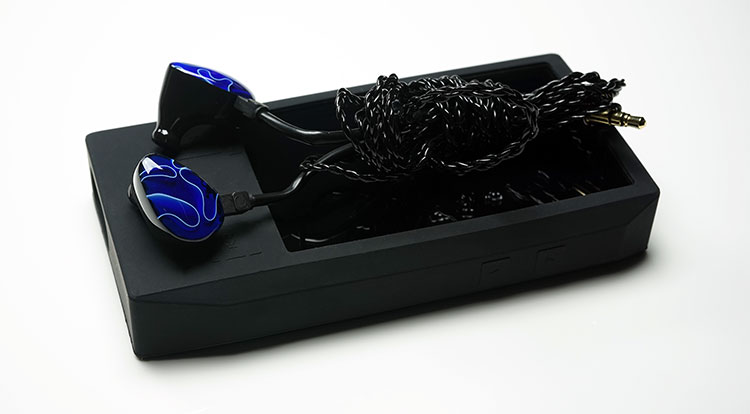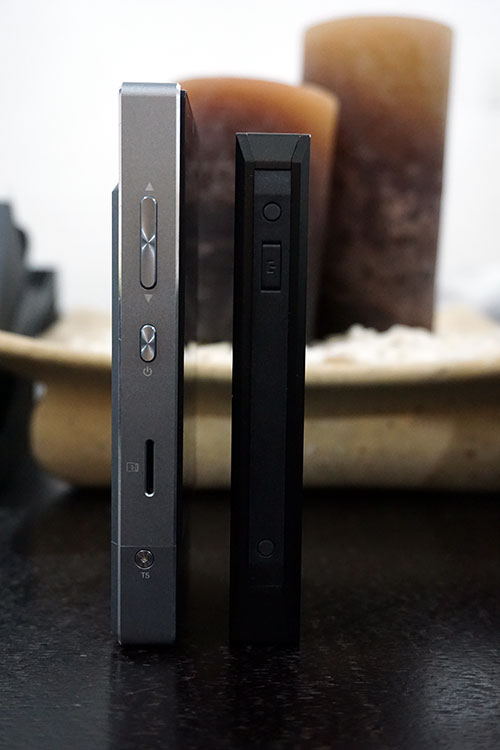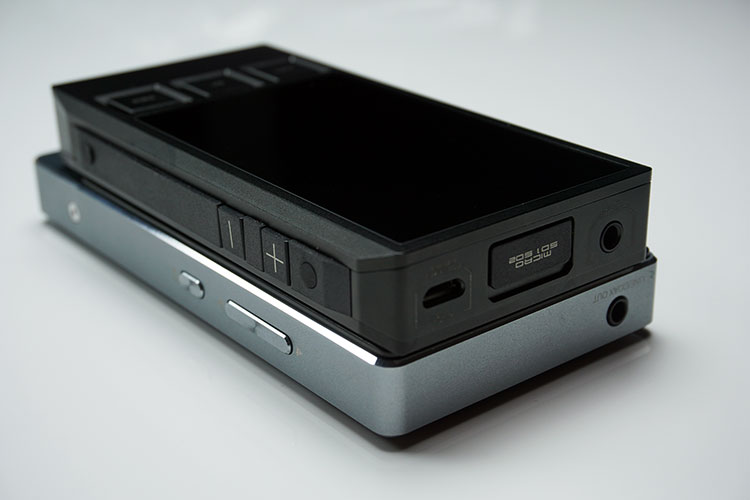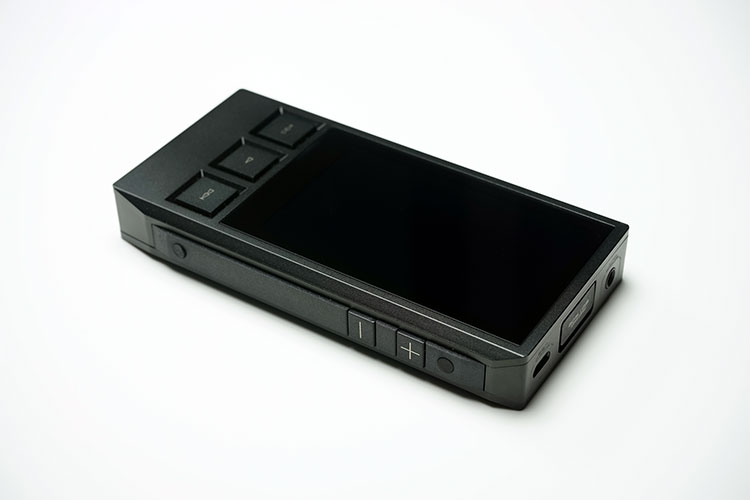Sound Impressions
Tonality
Tonally the DX80 does not stray that far from the DX90 sound – neutral to warm, smooth with great dynamics and a top end that is a real pleasure to listen to. The DX80 comes across as a very natural sounding DAP with a reasonably full sounding low end that extends very well indeed without sounding over emphasized or bloated and a crystal clear and focused mid-range combined with a relaxed but detailed treble performance and a tiny bit of sparkle north of 8k. What I love most about the DX80’s tonality is that at no point will it ever sound edgy, thinned out or too strident. The DX80 is musical with a spacious presentation and does an excellent job of keeping unwanted peakiness in check. At the same time though detail is never sacrificed, sibilance is controlled and the pace is snappy and realistic.
I have always been a keen advocate of the DX90 DAP as the mid-fi king of DAP’s given its OS flexibility and the overall sound is just that bit more to my liking than the equivalent FiiO and Hidizs range. The DX80 could end up replacing the DX90 because there are 1 to 2 notable tuning differences that for me make the DX80 an even better DAP to listen to despite the DX90 being supposedly the ‘higher’ DAP.
Vocals
On casual listening these tuning differences are not stand out but if you A/B with a flat reference IEM such as the Noble 4C you start to pick up on them, particularly with vocal tracks. The DX80’s vocal presence is just that more immediate and more forward than the DX90’s vocal performance. It also sounds a little bit cleaner and easier to pick out than the slightly more muted DX90. This is not a huge night and day experience by the way but it’s there. As a result, vocals on the DX80 sound a little bit more believable than the DX90.
Bass
I always felt the DX90 bass to be firmly planted with good body and extension, much more so than the DX50 and the X3ii/X5ii from FiiO. The DX80’s bass, however, is slightly dialled back in terms of emphasis making it sound more neutral and linear than the DX90. It is not a huge change and there is still some fullness to the mid-bass performance of the DX80 but it does feel tight and snappy and much more in keeping with the rest of the presentation than before. Subtle changes like this I appreciate from iBasso. Detail and texture is still excellent; extension is above average but this time I do not feel the mids lost out over the need for an impactful bass response. You could argue this time the bass on the DX80 is the more ‘technically correct’ of the two DAP’s.
Treble
Whilst I do not think the DX80 quite has the chops to master the top end detail and articulation of the DX90 it does extend well and avoids any nasty sibilant pitfalls and peakiness. Again iBasso have ensured the DX80 treble performance is neither strident or blunted but it is a little thinner than the DX90 treble performance which for me gives the DX90 a slight advantage. That being said it’s still a very pleasurable top end signature and that little peak around 7-10k range is just enough to put some welcome sparkle into the DX80’s treble range.
Soundstage
I actually think the DX80 soundstage is larger and more spacious than the DX90 with better separation and this is a big plus for me particularly in allowing the vocal presence to flow without a hint of congestion, even more so than the DX90 which falls back slightly in comparison. Width is excellent and imaging is spot on, easily outdoing the X3ii and Hidizs AP100 in terms of engagement. It is not so wide as to feel unnatural or disjointed either. This is a coherent soundstage and combined with the rather smooth and musical tonality makes it the DX80 a very pleasurable listen indeed.
Matchability
IEMs
Only on the most sensitive of IEM’s, the SE846 and the Campfire Audio Jupiter did I detect any sort of background hiss or noise on low gain. Mind you this is very minimal and nothing like the Shozy Alien/Theorem 720 type levels. The hiss on the SE846 was perhaps a little more present than the Jupiter. Once the music is flowing you can’t hear any noise. What you can hear on these very sensitive earphones is that very slight popping noise between tracks. This has been largely minimized with each successive firmware but if you are planning to use very sensitive earphones then it is detectable though fairly benign and fleeting in nature.
Campfire Audio Jupiter and Shure’s SE846
Of these two the Jupiter was excellent with the DX80 and my preferred choice. Those energetic mids and wide presentation of the Jupiter was a perfect match with the DX80’s own intimate and clear vocal presence as well as its excellent staging properties. The SE846 sounded as bit more recessed in comparison with a heavier bass response and requiring slightly more power to drive than the Jupiter. It just didn’t feel as coherent as the Jupiter using the Dx80.
Noble 4C and Sennheiser’s IE800
Less sensitive IEM’s such as the Noble 4C and the IE800 from Sennheiser, the Westone W4 and the Roxanne suffered no such background noise issues. The Noble 4C’s flat referencing, usually a boring attribute, sounded positively brimming with character on the DX80. I actually conducted most of the review using the 4C. The IE800’s normally fragile top end sounded reasonably settled and smooth though the low end was a bit more dominant than what I would have wanted given how I enjoyed the DX80’s vocal performance. The IE800 also needed about 15 steps more volume boost to get close to the Jupiter and 10 steps higher than the 4C to get volume parity.
Headphones
Efficient planars and low to medium ohm dynamic headphones such as the HE400s, Oppo PM-3 and the AKG K812 has no issues being driven by the DX80 jacked straight out of the DX80 headphone output jack on high gain.
HE400s
The HE400s sounded suitably smooth and mid-range centric with the DX80 on a high gain 105 volume setting. I actually really enjoyed this smooth pairing. The HE400S mid-range was competitive and vocals sounded competitive especially with harmonic rock vocals such as Pink Cream 69. I think you can get more out of the HE400S with stronger amping but as DAP matching goes tonally this was a good one.
Oppo PM-3
The Oppo PM-3 sat a few steps lower at around 95-100 on high gain compared to the HE400s and also sounded very compelling with a snappy low end, good treble performance and a clear mid-range. It lost out a bit to the open ended HE400S though in terms of soundstage and spaciousness, two of the big traits of the DX80. As a closed headphone though it’s not surprising that will be the case. I also preferred the HE400S mid-range a bit more over the PM-3 using the DX80. The balance is there but it just lacks a bit of bite and crunch compared to the HE400S for hard rock guitar work which benefited more from the spacious sound of the HE400S.
AKG K812
Sat at similar levels to the HE400S at around 100-105 on high gain so no issues on achieving adequate levels of volume. A 32-ohms headphone shouldn’t really pose too many problems for the DX80. You can get more out of the AKG K812 when properly amped but I have to say the DX80 was a decent match with the K812. Highs did not seem too strident or peaky though bass was restrained if a little too polite at times. Vocal performance was very good indeed, much better than I expected with this pairing sounding natural and clear.
Comparisons
FiiO X5ii & FiiO X3ii
Both the FiiO DAP’s are entirely hardware based for functionality and OS management lacking in any sort of touch sensitive screen or controls and instead being managed by a more traditional scroll wheel. for me the Dx80 hybrid hardware playback keys and larger capacitive touchscreen easily wins on usability over the more traditional FiiO units. Granted the X5ii and X3ii firmware is a mature OS as of now but V1.3.3 from Ibasso is close if not on a level with FiiO in terms of stability and accuracy.
In terms of usability the DX80 3-page UI system is much faster to access and play with than the more linear “in and out” wheel and button system of the X5/X3ii DAP’s. Quick swipes left and right to adjust gain and gapless in the DX80 take a second at most whilst the FiiO DAP’s take much longer and are not necessarily that intuitive in comparison.
The DX80 also has an edge in battery performance rated at 13 hours which is 3 hours longer than the X5ii 10-hour rating and a slight edge over the X3ii’s smaller 2600mAh battery by about 1-2 hours. All 3 can act as DAC’s connected to your PC or MAC, the X3ii uses the same DAC chip as the DX80 (CS4398) and all 3 can decode DSD natively so in many respect technical ability is very close for all 3 DAP’s. The DX80 has a slight advantage in terms of outputs with a mini optical output and not just a coaxial output found in the FiiO DAP’s but DSD output is still not possible via the DX80 digital outputs.
The X3ii has only one microSD slot compared to the X5ii and the DX80 which have two microSD slots. I do slightly prefer the wider microSD slot configuration of the X5ii. At times the DX80 config is a bit tight and fiddly to work with cards quickly and the use of just slot 2 for upgrading the firmware is a bit of a hindrance in the DX80.
Tonally they do differ though. Both of the FiiO units are more neutral to my ears than the slightly more natural and intimate sounding DX80. The DX80 comes across as the more musical of the three with a fuller low end and a more intimate and forward vocal presence than either of the FiiO DAP’s. The X5ii’s mid-range is excellent and the transition to treble is smooth with much of that glare from the original X5 gone but the energy and snap of the DX80 combined with a fuller low end just makes it the slightly more engaging of the two.
Shozy Alien (Silver Edition)
There are some obvious points here to draw comparison from not least the fact that the Alien has far less functionality and lacking in any sort of screen nevermind a touch screen. It also has a shorter battery life at just 8 hours on paper compared to the more durable 13 hours touted by iBasso for the DX80. Yes, its half the price of the DX80 and is touted for its audio capabilities over any other feature. If you need a screen, DAC etc then get the DX80, it is a no brainer. If you want a secondary ninja weapon and a near indestructible form factor and build then the Alien maybe just for you.
Judge these two purely on audio performance instead if you want a comparison. When I say audio I do mean tonality because the Alien will not decode DSD and tops out actually at a lowly 16 and 24 bit 44.1k loseless so your options are a bit restricted in that sense compared to the DX80. On that basis noise levels are higher on the Alien than the DX80 and whilst both have an excellent mid-range the DX80 is the more resolving and detailed of the two. Treble performance is also superior on the DX80 in terms of detail and the bass body that bit fuller with more texture.
What I love though about the Alien is the soundstage and here it is more competitive against the DX80 which is also an airy and spacious sounding DAP. It’s the primary reason why I love the Alien, that engaging big sound it is able to produce. For detail and dynamics though the DX80 wins.
FiiO X7
The X7 is double the price for a very good reason. It is just that bit more ambitious, packing the very credible desktop worthy Sabre ES9018S DAC chip, a very matured Android OS and a modular amp system that should give the X7 life cycle plenty of legs.
This match up sort of reminds me of Batman Vs Superman with the more mortal DX80 matching up to the more celestial X7 yet the DX80 packs plenty of tricks and can distract, irritate and stand close to the X7 without actually ever overpowering it. It is cheaper, got dual microSD slots, looks a bit more durable, packs more digital out connections and comes with a silicone case already in the package. Yet the X7 just feels more complete as a DAP and more involving with BT, streaming hi-res, multiple modules it suddenly starts to really grow on you.
You could argue the X7 IEM module is not as musically involving as the DX80 and to some extent you would be very correct. The DX80 sounds richer, more full bodied and fun than the more neutral X7 IEM module. But the detail is with the X7 and with the AM2 a lot of that initial area of concern fades away with better power performance on headphones and a cleaner blacker background with most IEMs. The AM2 module’s better musicality really pushes the X7 way above the DX80 but at a total cost of ownership that is double the DX80 price. People ask me which is better? Of course the X7 is but it really should be at twice the price so I do not see the logic in this face off.
Sony NWZ-ZX1
It’s another, slightly slower, Android creation and this time from Sony. This one created a slight stir in the consumer mags for some odd reason being slated as too expensive and yet missing AK’s fleet of luxury DAP’s at twice the price. Odd that. Anyhow the Sony for me is not as powerful or as durable as the X7 though it is more svelte and better engineered physically than the X7. It does pretty much what the X7 does only slightly slower. If your preference is for a Sony version of Android then it does look a lot prettier than the DX80 and also quite a bit thinner and built to a very high standard indeed. Between the DX80 and the ZX1 on a shelf in a store near you my bet is the Sony will get a lot more touch time than the DX80.
But this is Sony and as always Sony design by committee means it is never a home run. A proprietary cable, fixed memory and no memory card slot and a sluggish version of Android means it can be a frustrating experience it doesn’t quite have the functional snap of the DX80 UI even if it sports more secondary features. By contrast the DX80 uses a bog standard mini USB connection, can handle OTG and up to 2TB in memory for a fraction of the price.
Tonally speaking the DX80 is a quite a different beast to the ZX-1. The ZX-1 has a more dominant if slightly slower bass signature than the DX80. It also has substantially more hiss with super sensitive IEMs than the DX80 such as the Jupiter and SE846. The mid-range of the DX80 is also more energetic and fuller sounding. This is a more forward sounding mid-range than the ZX-1. The Sony though is a more resolving than the DX80 with much better micro detail retrieval. Timbre on the Sony also sounds just that bit more realistic than on the DX80.
Final Thoughts
When iBasso first touted the DX80 on paper I fully expected it to be their flagship. The specs looked pretty good and the addition of a bigger LCD certainly gave the impression it might be a continuation of that phony FiiO war among fans of each. Then came the price, $359. This is not the next level up so to speak but a complete replacement of the older DX line up, the DX50 and DX90. Their discontinuation before the launch of the DX80 should have been a big clue to those studying the form books that the DX80 was not going to be the X7 killer.
It is however a step ahead of the FiiO X5ii, it’s price equivalent and something that is still being sold today by FiiO (for how much longer I am not sure). Careful analysis of the DX80 will also yield quite a few DX50/90 features but now it is wrapped in a thoroughly more modern body, equipped with a better LCD screen, a simpler and now a more stable UI and much better memory capacity. It has made FiiO’s gen 2 models look quite conservative in their functional and physical upgrades.
Tonally it is an excellent and natural sounding DAP that is highly musical and should ideally replace my Alien as the vocal and mid-range DAP of choice below $400. The DX90 might still have some chops when it comes to detail retrieval and treble performance but the DX80’s more organic sound and more neutral bass performance produces a nicer presentation. I was sad that the DX90 went out of production but the DX80 is a very nice replacement indeed and something I could listen to for quite some time without missing the DX90 too much.
Technical Specifications
- DAC: 2 × CS4398
- SoC: RockChip RK3128
Headphone output (at 32Ω load)
- Frequency range: 17 Hz – 20 kHz ± 0.1 dB
- Output power: 260 mW
- Output voltage: 2,9 Vrms
- The ratio signal/noise ratio: 114±1 dB
- Total harmonic distortion + noise: 0,002%
- Channel separation: 70 dB
Line out
- Frequency range: 17 Hz – 20 kHz ± 0.1 dB
- Output voltage: 1,6 Vrms (1 kHz, 0 dB)
- The ratio signal/noise ratio: 116±1 dB
- Total harmonic distortion + noise: 0,001%
- Channel separation: 107 dB (1 kHz)
Different
- Formats support: APE, FLAC, ALAC, WMA, WAV, AAC, AIFF, OGG, MP3, DFF, DSD, DXD
- Resolution support: up to 192 kHz/24-bit
- Screen: 3,2″ TFT, 480 × 800
- Battery: 3600 mAh, 3.8 V
- Working time on a single charge: up to 13 hours
- Charging time from 2A charger: 3 hours
- Inputs: Micro USB
- Outputs: nauchnikov, linear, optical/coaxial SPDIF
- Memory cards: 2 x MicroSD up to 2 TB
- Dimensions: 120 mm x 63,2 mm × 16.8 mm
- Weight: 178 g






